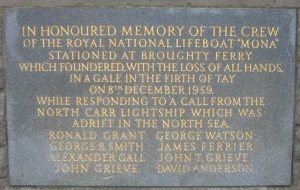Explorer to the Rescue
Stormy Weather
Having spent many a stormy December at sea, as scientist in charge of the modern-day Scotia ie Scotia four, I was very interested in a little bit of history, which demonstrates that what goes around comes around!
In December 1959 Dr “Jake” Fraser an eminent zooplanktologist, was scientist in charge of Scotia two, a converted trawler minesweeper when the weather turned distinctly nasty.
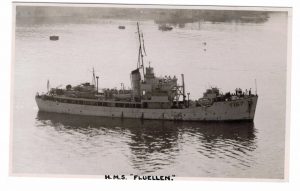
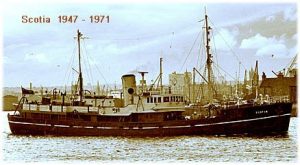
December 6th 1959
As reported by the press, local and national, one of the worst storms in living memory raged for four days starting on Sunday 6th December 1959. The Aberdeen trawler George Robb was the first vessel to come to grief, bound for the fishing grounds she was swept ashore near Duncansby head and tragically all twelve of her crew perished. A coastguard from Wick who had gone out with the lifesaving company to try to help, unfortunately, collapsed and died on his way to the wreck.
On Tuesday 8th the 361 ton Leith cargo ship Servus en route from Leith to Wick and Kirkwall with a cargo of coal, unfortunately, suffered a broken propeller shaft. This, of course, meant the vessel was drifting helplessly in huge seas and ferocious winds towards the rocky Caithness coast.
Mayday
The master of the Servus, John Pirie an experienced master mariner from Portlethen, put out a mayday message which was answered by the Scotia. It should be remembered that manoeuvring a steam-powered vessel like the Scotia in these conditions required significant seamanship and courage. I personally can vouch for the fact that the Scotia had atrocious sea keeping, rolling freely and violently, with side decks full of water, responding very slowly to steering or main propulsion. She didn’t, of course, have thrusters or indeed anything other than a rudder and the main prop to try to hold her in position. The Scotia did manage to get a line fired by rocket aboard the stricken vessel and started towing it to safety. Although this must have been painfully slow, as the Scotia, was underpowered having a very small three-cylinder steam reciprocating engine and screw, her top speed in good conditions was only nine knots.
Over two hours, which must have seemed like an eternity in the conditions, the tow broke several times, again and again, the Scotia managed to get a line aboard and restart the tow, however when it broke yet again, the Scotia had no more rockets left, and the situation appeared hopeless. They did try to get a line aboard by throwing it, and using a makeshift catapult, but in the extremely strong winds and mountainous seas, this was futile. Scotia did, however, standby the vessel to try to render whatever help they might. Now the second research vessel Explorer (now in Leith in preservation ) arrived on the scene along with the Aberdeen trawler Aberdeen progress, and both these vessels used their rockets trying desperately to get a line aboard the stricken vessel without success. At this time they were less than five miles off the coast and the master of the Servus ordered both anchors to be dropped in an effort to try to slow the vessel’s drift inexorably towards the lethally rocky coast. However the seas were so mountainous and the wind so fierce, storm force fifteen, the master of the Servus reported that he had never experienced anything like it in all his time at sea, and both anchors were completely and violently ripped off.
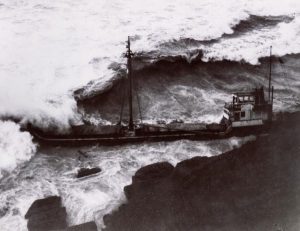
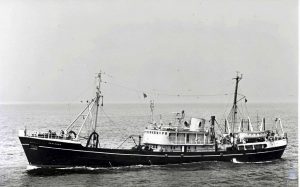
Cromarty Lifeboat
The heroes of Cromarty lifeboat in their tiny vessel, made it to the stricken vessel now virtually on the rocks, in the early hours, and managed to get a line aboard, as the crew lined up on deck ready to abandon ship. The Servus was rolling and pitching so violently, decks completely awash, that only three of the crew managed to get into the lifeboat first time, as it came alongside for the second time , sometimes below the stricken vessel and sometimes above it on huge waves, one of the able seamen from Wick said he just could not jump, but a loud voice from the lifeboat shouted, “come on I’ll catch you,” and he did. The second engineer was in the wheelhouse holding on to the ship’s wheel trying desperately to keep her on a course to allow the lifeboat to come alongside again when a huge wave hit the vessel and the wheelhouse causing the wheel to kick so hard it spun him a complete cartwheel, flinging him to one side of the wheelhouse and knocking him out temporarily and bruising is head and legs badly.
All eight of the crew including the master, the last man to leave the ship, were saved and made the tortuous eighteen-hour journey back to port safely aboard the cramped lifeboat, where they were given warm dry clothes and a meal by members of the local community, before going home.
Other Casualties
The Servus grounded below Dunbeath Castle and was completely wrecked, it was not the only vessel lost on the east coast of the North sea during that terrible gale, two other ships the Norwegian freighter Elfrida and the German coaster Merkur foundered with the loss of twenty-seven lives, twenty on the Elfrida and seven on the Merkur
For everyone on board both the Scotia and Explorer, the weather and experience must have been extremely scary, uncomfortable, and dangerous, and they would all I would imagine have been relieved, that the eight men from the Servus were saved given the loss of life elsewhere in the area over those horrendous four days. Not often that two research vessels from the same institution, if at all, are involved in responding to a marine rescue.
Times have changed, Scotia four is a very safe stable, powerful platform fitted with modern lifesaving equipment, however, in storm conditions, anything can happen even to the best-found vessels. I was on board Scotia in Dec 1998 when we were struck by a very large wave which significantly damaged the vessel and left it with no propulsion for twenty-four hours. This was a very worrying time for all aboard, but the ship performed very well and was able to make its own way to a little Norwegian port called Sandnessjoen, despite the fact that the Norwegian authorities had sent out a small tug called the Boa Siv to assist. After an assessment of the damage, some repairs, and a good clean up the vessel abandoned the survey and made its way back to Aberdeen under her own power.
The lessons are as valid today as they were in 1959, do not underestimate the power of the sea, no matter what you are aboard. Support the RNLI as they are prepared to go to the assistance of any vessel in trouble.
Dedicated to my former colleague Norman Nicoll, who was on the Scotia in 1959 and graphically recounted the story to me while in hospital with terminal liver cancer, a battle which he sadly lost.
During the same storm, on the 8th December 1959, the Broughty Ferry lifeboat Mona was launched to assist the North Carr Lightship. During the rescue attempt, the Mona foundered with the loss of all eight of her crew. Broughty Ferry Lifeboat Disaster
